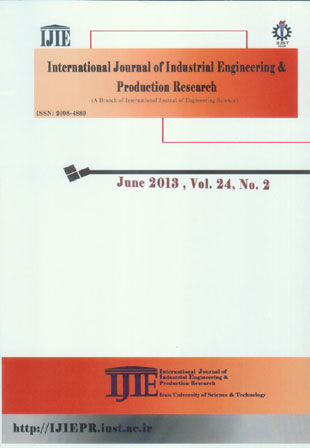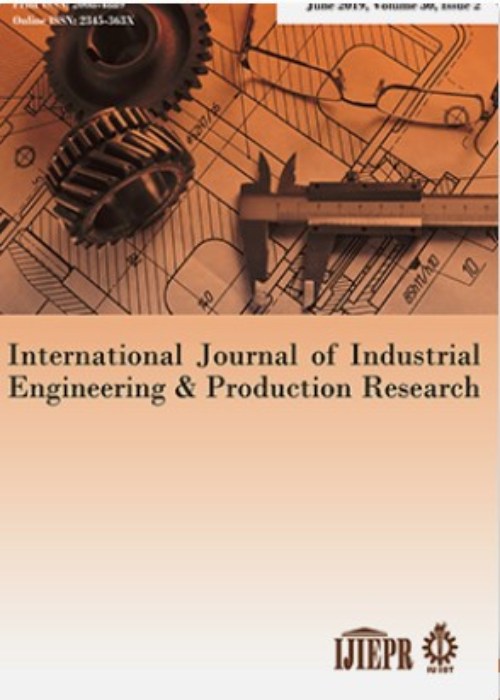فهرست مطالب

International Journal of Industrial Engineering and Productional Research
Volume:24 Issue: 2, Jun 2013
- تاریخ انتشار: 1392/04/12
- تعداد عناوین: 7
-
-
Pages 101-106Redundancy technique is known as a way to enhance the reliability and availability of non-reparable systems, but for repairable systems, another factor is getting prominent called as the number of maintenance resources. In this study, availability optimization of series-parallel systems is modelled by using Markovian process by which the number of maintenance resources is located into the objective model under constraints such as cost, weight, and volume. Due to complexity of the model as nonlinear programming, solving the model by commercial softwares is not possible, and a simple heuristic method called as simulated annealing is applied. Our main contribution in this study is related to the development of a new availability model considering a new decision variable called as the number of maintenance resources. A numerical simulation is solved and the results are shown to demonstrate the effecienct of the method.Keywords: Availability optimization, Maintenance resource, Redundancy level
-
Pages 107-112Monitoring the reliability of products in both the manufacturing and service processes is of main concern in today’s competitive market. To this end, statistical process control has been widely used to control the reliability-related quality variables. The so-far surveillance schemes have addressed processes with independent quality characteristics. In multistage processes, however, the cascade property must be effectively justified which entails establishing the relationship among quality variables with the purpose of optimal process monitoring. In some cases, measuring the values corresponding to specific covariates is not possible without great financial costs. Subsequently, the unmeasured covariates impose unobserved heterogeneity which decreases the detection power of a control scheme. The complicated picture arises when the presence of a censoring mechanism leads to inaccurate recording of the process response values. Hence, frailty and Cox proportional hazards models are employed and two regression-adjusted monitoring procedures are constructed to effectively account for both the observed and unobserved influential covariates in line with a censoring issue. The simulation-based study reveals that the proposed scheme based on the cumulative sum control chart outperforms its competing procedure with smaller out-of-control average run length values.Keywords: Multistage processes, Frailty models, Cox proportional hazard (PH) models, Cumulative sum (CUSUM) control chart, Probability limits
-
Pages 113-121control of production processes in an industrial environment needs the correct setting of input factors, so that output products with desirable characteristics will be resulted at minimum cost. Moreover, such systems havetomeetset of qualitycharacteristicstosatisfycustomer requirements.Identifyingthemosteffectivefactorsindesignoftheprocesswhichsupportcontinuousandcon inualimprovement isrecentlydiscussedfromdifferentviewpoints.Inthisstudy, we examined the quality engineering problems in which several characteristics and factors are to be analyzed through a simultaneous equations system. Besides, the several probabilistic covariates can be included to the proposed model. The main purpose of this model is to identify interrelations among exogenous and endogenous variables, which give important insight for systematic improvements of quality. At the end, the proposed approach is described analytically by a numerical example.Keywords: Design of experiments, Multiple Response Optimization (MRO), robust design, probabilistic covariate, System regression
-
Pages 123-129Identification of a real time of a change in a process, when an out-of-control signal is present is significant. This may reduce costs of defective products as well as the time of exploring and fixing the cause of defects. Another popular topic in the Statistical Process Control (SPC) is profile monitoring, where knowing the distribution of one or more quality characteristics may not be appropriate for discussing the quality of processes or products. One, rather, uses a relationship between a response variable and one or more explanatory variable for this purpose. In this paper, the concept of Maximum Likelihood Estimator (MLE) applied to estimate of the change point in binary profiles, when the type of change is drift. Simulation studies are provided to evaluate the effectiveness of the change point estimator.Keywords: binary profiles, change point, maximum likelihood estimator (MLE), statistical process control (SPC), control chart
-
Pages 131-136Response surface methodology is a common tool in optimizing processes. It mainly concerns situations when there is only one response of interest. However, many designed experiments often involve simultaneous optimization of several quality characteristics. This is called a Multiresponse Surface Optimization problem. A common approach in dealing with these problems is to apply desirability function approach combined with an optimization algorithm to determine the best settings of control variables. As the response surfaces are often nonlinear and complex a number of meta-heuristic search techniques have been widely for optimizing the objective function. Amongst these techniques genetic algorithm, simulated annealing, tabu search and hybridization of them have drawn a great deal of attention so far. This study presents the use of harmony search algorithm for Multiresponse surface optimization. It is one of the recently developed meta heuristic algorithms that has been successfully applied to several engineering problems. This music inspired heuristic is conceptualized from the musical process of searching for a perfect state of harmony. The performance of the algorithm is evaluated by an example from the literature. Results indicate the efficiency and outperformance of the method in comparison with some previously used methods.Keywords: Multiresponse surface optimization, Harmony search algorithm, metaheuristic search techniques, Response surface methodology, Design of experiment
-
Pages 137-142In certain statistical process control applications, quality of a process or product can be characterized by a function commonly referred to as profile. Some of the potential applications of profile monitoring are cases where quality characteristic of interest is modelled using binary,multinomial or ordinal variables. In this paper, profiles with multinomial response are studied. For this purpose, multinomial logit regression (MLR) is considered as the basis.Then, the MLR is converted to Poisson GLM with log link. Two methods including Multivariate exponentially weighted moving average (MEWMA) statistics, and Likelihood ratio test (LRT) statistics are proposed to monitor MLR profiles in phase II. Performances of these three methods are evaluated by average run length criterion (ARL). A case study from alloy fasteners manufacturing process is used to illustrate the implementation of the proposed approach. Results indicate satisfactory performance for the proposed method.Keywords: Loglinear Models, Average Run Length (ARL), Multivariate Exponentially Weighted Moving Average (MEWMA), Multinomial Logit Regression, Profile Monitoring
-
Pages 143-150The main advantage of heuristic or metaheuristic algorithms compared to exact optimization methods is their ability in handling large-scale instances within a reasonable time, albeit at the expense of losing a guarantee for achieving the optimal solution. Therefore, metaheuristic techniques are appropriate choices for solving NP-hard problems to near optimality. Since the parameters of heuristic and metaheuristic algorithms have a great influence on their effectiveness and efficiency, parameter tuning and calibration has gained importance. In this paper a new approach for robust parameter tuning of heuristics and metaheuristics is proposed, which is based on a combination of Design of Experiments (DOE), Signal to Noise (S/N) ratio, Shannon entropy, and VIKOR methods, which not only considers the solution quality or the number of fitness function evaluations, but also aims to minimize the running time. In order to evaluate the performance of the suggested approach, a computational analysis has been performed on the Simulated Annealing (SA) and Genetic Algorithms (GA) methods, which have been successfully applied in solving respectively the n-queens and the Uncapacitated Single Allocation Hub Location combinatorial problems. Extensive experimental results showed that by using the presented approach the average number of iterations and the average running time of the SA were respectively improved 12 and 10.2 times compared to the un-tuned SA. Also, the quality of certain solutions was improved in the tuned GA, while the average running time was 2.5 times faster compared to the un-tuned GA.Keywords: Parameter Tuning, Design of Experiments, Signal to Noise (S, N) ratio, Shannon Entropy, VIKOR, Simulated Annealing, Genetic Algorithms


